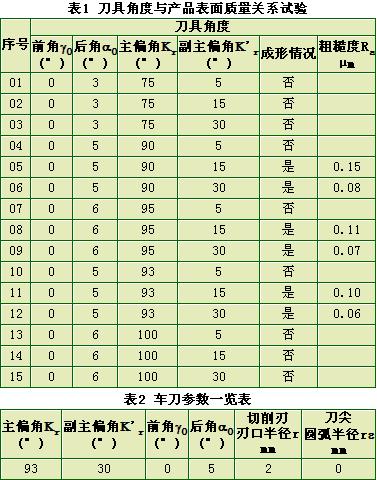Abstract : The processing of micro-nano-scale devices is one of the key technologies for the development and application of MEMS systems. Through the cutting test, a diamond turning tool capable of machining a micro-axis with a minimum diameter of 7μm is designed. The main parameters are: main declination Kr=93°, declination K'r=30°, rake angle g0=0°, The back angle a0=5°. Then, taking the axis with a diameter of 20μm as an example, the effects of feed rate, back-feeding amount and spindle speed on micro-axis forming and surface roughness were analyzed. The results show that in the processing of micro-axis, the amount of cutting not only affects the quality of the working surface, but also whether it can be formed by turning. In the formable range, the feed amount is proportional to the surface roughness value, which has a significant effect; the back-feeding amount and the spindle speed have little effect on the surface roughness. Finally, the limit example products under different processing parameters were trial-produced.
Foreword
In recent years, with the increasing maturity of MEMS technology research and development, MEMS products require high-efficiency micro-device processing technology. Therefore, micro-machining technology is receiving increasing attention. The demand for micro-axis below Ø0.1mm is becoming more and more urgent in fields such as computers, microelectronic instruments and laser fusion (ICF). At the same time, ink jet nozzles, electron guns and ICF physical diagnostic equipment such as inkjet printers require micron-sized micropores, which are usually formed by EDM or ultrasonic machining using a micro-axis as a tool. The micron-scale micro-axis machining methods currently reported are mainly EDM, electrolytic machining, ultrasonic vibration grinding and special processing methods such as LIGA. Common problems with these methods are inefficiency, expensive equipment, complicated processes, and high technical requirements for operators, hindering the development of microdevice processing. The traditional cutting technology is more mature, can it play a role in micro device processing? There are few reports in this area. With the support of the high-density and high-density plasma national defense science and technology laboratories, using copper as the workpiece material, through a series of experiments, the precision turning technology of the micro-slim shaft was discussed. The result proves that the precision turning technology is processed in the micro-scale slender shaft. Aspects have their unique advantages.
1 Design of turning tool for micro-axis turning
The fine shaft has a large long diameter and poor rigidity, and is very sensitive to cutting force, vibration and cutting temperature. When turning, it is easy to produce bending deformation and vibration, which brings a series of difficulties to the cutting process, and the geometric accuracy and surface quality are not guaranteed. The main factors affecting the precision of the micro-axis machining include: cutting force, cutting thermal deformation, tool thermal deformation, internal stress and tool mounting height error. The above factors are related to the material of the tool, the tool parameter lead angle Kr, the auxiliary declination K'r, the rake angle g0, the back angle a0, the cutting edge radius r and the tool nose radius.

Next page
Matrix Panel ,Led Matrix Light,Matrix Stage Light,Dmx Led Matrix Light
EV LIGHT Guangzhou Co., Ltd , https://www.evstagelights.com